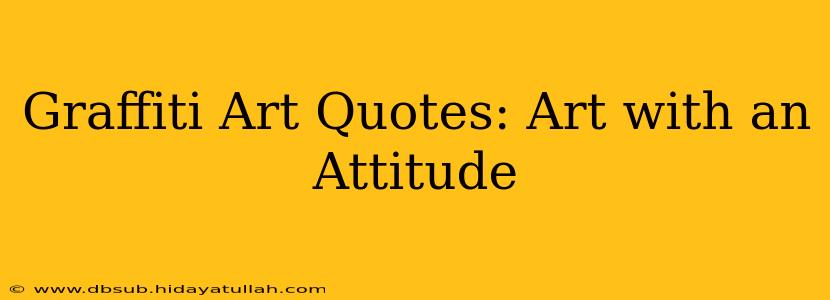Graffiti art. The very term evokes a range of reactions, from outrage to awe. It's a powerful form of expression, often controversial, always bold, and undeniably impactful. More than just vandalism, it's a vibrant subculture with its own rich history, skilled artists, and a wealth of inspiring (and sometimes defiant) quotes. This exploration dives into the world of graffiti art quotes, examining their meaning and the artists behind them. We'll also tackle some frequently asked questions to give you a complete understanding of this fascinating art form.
What are some famous graffiti art quotes?
Pinpointing the most famous is tricky, as many iconic graffiti quotes are tied to specific artists and pieces, often lacking formal attribution. However, the spirit of graffiti lends itself to certain recurring themes reflected in countless slogans and tags. Many quotes center on freedom of expression, social commentary, rebellion against authority, and the ephemeral nature of the art itself. Think of phrases like "Art is not a thing; it is a way," reflecting the process-driven nature of many graffiti artists' work. Or the bold assertion, "The walls are my canvas," which speaks to the reclamation of public spaces. These aren't necessarily direct quotes from famous artists, but rather encapsulate the ethos of the movement itself.
What are some quotes about graffiti art from famous artists?
While many graffiti artists remain anonymous or use pseudonyms, some have achieved recognition, offering insightful quotes on their craft. Unfortunately, direct quotes from legendary figures like Jean-Michel Basquiat, who blended graffiti with fine art, are often scattered across interviews and biographical materials and lack the concise, quotable nature of traditional artist statements. However, their work itself speaks volumes. Basquiat’s raw, powerful imagery, for example, conveys a potent message about social inequality and the artist's own struggle for recognition. The same holds true for many other significant figures in the movement; their art is their most eloquent statement.
What is the difference between graffiti and street art?
This is a crucial distinction often blurred. Graffiti, in its purest form, typically refers to unauthorized markings—tags, throw-ups, and pieces—often created quickly and with a focus on style and territoriality. Street art, while often found in similar locations, is generally more elaborate, often involving complex murals, stencils, and installations, and sometimes involves prior permission from property owners. While there's overlap, the key differentiator lies in intent and the level of permission (or lack thereof).
Is graffiti art considered vandalism?
This is a subjective question. Many consider graffiti vandalism, purely based on the unauthorized nature of the work and the potential damage to property. Others see it as a form of public art, a vibrant counter-culture expression, or even a critique of societal norms. Legally, it's almost universally considered vandalism unless specific permits are obtained beforehand. The debate hinges on the interpretation of artistic intent versus property rights. The line blurs further when considering legally sanctioned street art projects, which often grace city walls with permission and planning.
How do I start creating graffiti art?
Creating graffiti art involves a steep learning curve. It's not merely about grabbing a can of spray paint; mastering different styles, techniques, and color blending takes time and practice. Start by researching different graffiti styles (tags, throw-ups, wildstyle, etc.), practicing on canvases or legal walls before attempting anything on private property. The key is to learn the fundamentals of composition, color theory, and lettering before moving to larger-scale projects. Online tutorials and workshops can be invaluable for learning techniques and mastering the art of spray painting.
Disclaimer: This article is for informational purposes only. Creating unauthorized graffiti is illegal and can lead to prosecution. Always obtain permission before creating artwork on any surface that is not your own.
